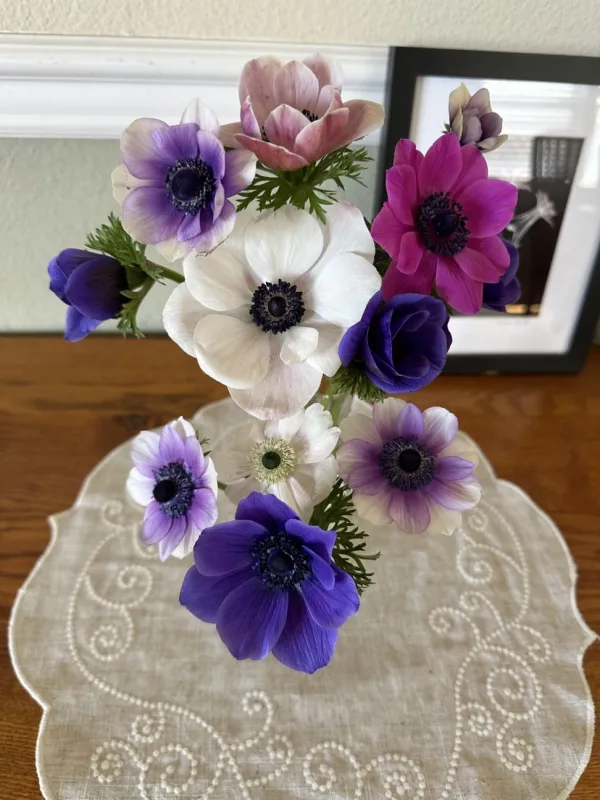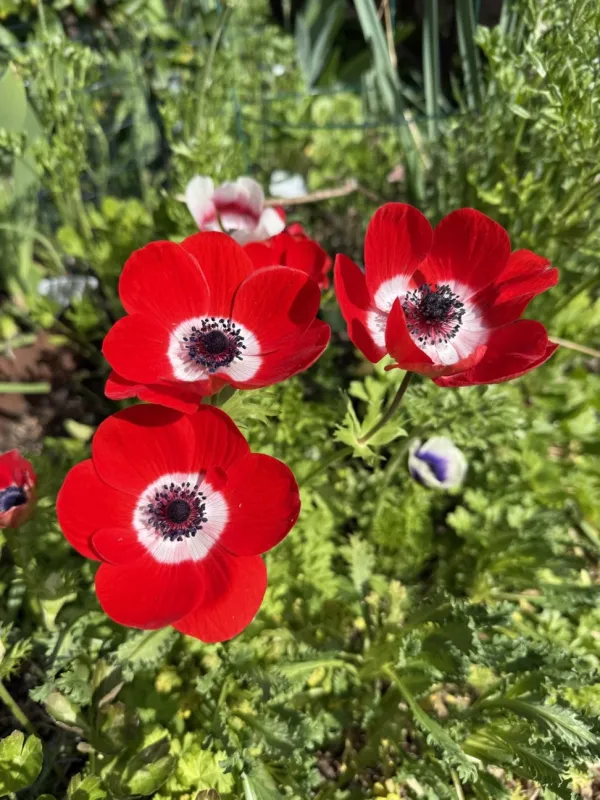Anemones for Early Spring Color
Blog by Erin Mahaney, UC Master Gardener

Sometimes, the simple pleasure of an early-blooming blossom can greatly minimize the doldrums of a chilly, grey winter day. Anemones are one of my favorite easy-to-grow flowers, brightening my yard and filling my vases in the early spring.
There are dozens of cultivars or varieties of anemones. The flowers range in colors from white to pink to red to blue to burgundy, as well as others. The blossoms are available in pastel or jewel tones and in single or double flowers. There are so many choices! I like to plant a variety of anemones, but I always include at least one white cultivar to mix in bouquets or to glow by itself in its own vase.

I generally plant two varieties for different purposes. Anemone blanda is also known as the Grecian windflower. It is low-growing, with fine, daisy-like petals that provide early spring color in nooks and crannies around the yard. I plant Anemone coronaria for the taller cut flowers and pops of color in the garden. These anemones are not to be confused with the Japanese anemone that blooms in the fall and spreads by creeping rhizomes.
Anemones grow from corms, which look like small, shriveled rocks. Like bulbs, corms are underground stems that store nutrients. Unlike bulbs, which are layers of leaves surrounding a bud, corms are solid storage tissues. Other plants that grow from corms including freesia and crocuses. Every time I plant an anemone corm, I am amazed that something so beautiful can grow from an insignificant little “pebble.”
In our climate (USDA Plant Hardiness Zone 9b), anemone corms can be planted in late fall or early winter. I prefer to plant mine in the late fall because the weather is nicer for planting and I get the benefit of earlier-blooming flowers in the winter.
Most people recommend soaking the corms for 3-4 hours (but no longer) in lukewarm water to plump them up before planting. I often skip this soaking step and the corms seem to sprout just as well. The corms can be planted directly in the ground or presprouted by starting them in trays before planting. Presprouting will allow for earlier blooms. I tried presprouting the corms once and it was fun to watch them grow so quickly in the trays, but in our relatively mild climate, it isn’t an essential step. Unlike some bulbs or corms, there is no “right side up” and anemones will grow no matter which direction they are planted.
Plant in full sun or partial shade in well-drained soil. Follow the planting instructions on the package that are specific to the anemone cultivar, but in general, the corms are planted approximately 1”-3” deep (depending on the cultivar) and 3-4” apart. Provide moderate water.
Anemone flowers can last over a week in a vase. It is best to cut them in the morning when the plants are hydrated. The flowers bloom on shorter stems at the beginning of the season and on longer stems as the plant matures. Don’t pick the flowers too early or else they may not open. I haven’t tried it yet, but I’ve read that the best time to harvest the flower is when the flower’s “collar,” which is the small leaf below the flower, has developed at least 1/4” of stem between it and the flower. Leave the foliage on the plant after the blooms have finished so that the plant can gather energy for next year’s growth.
While anemones may bloom the following year, I prefer to plant more each fall to ensure that I have flowers the next spring. Plus, it’s fun to try new varieties!

